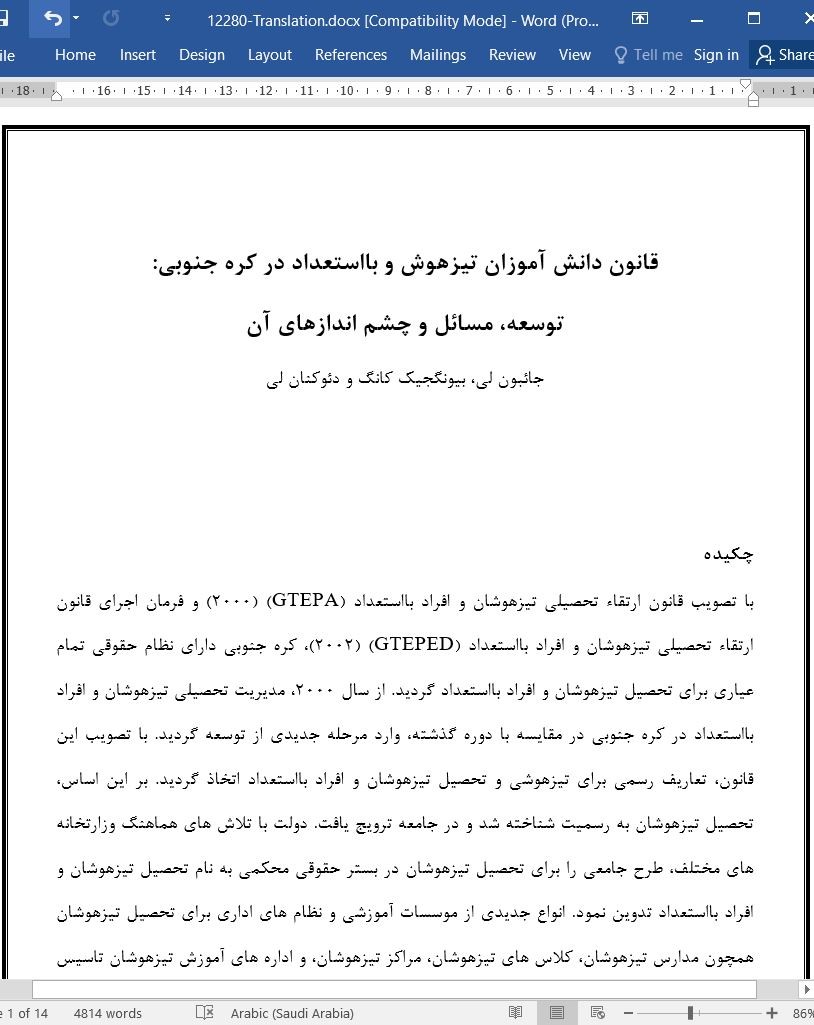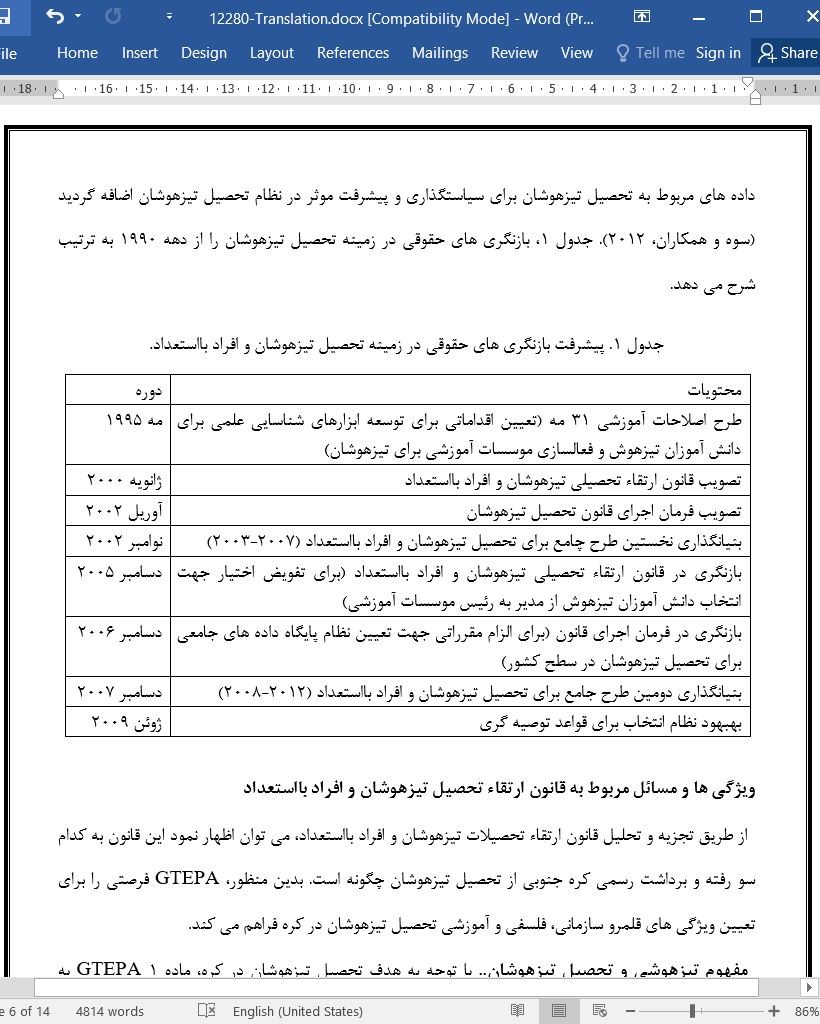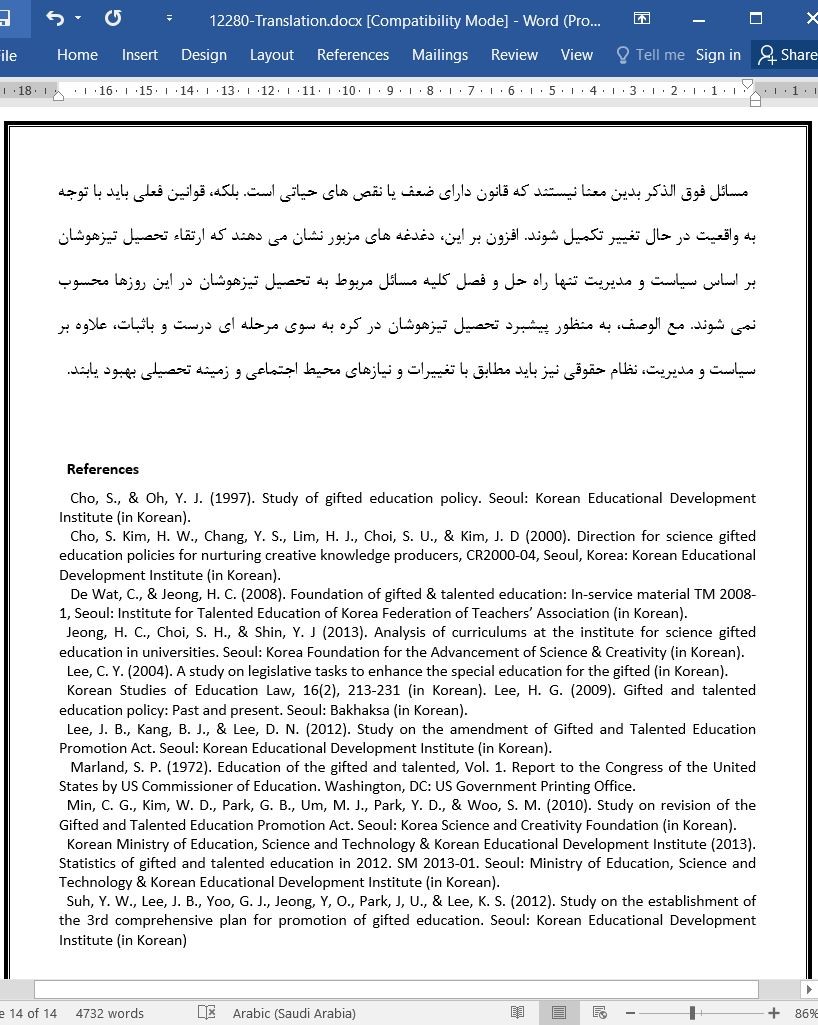
قانون دانش آموزان تیزهوش و بااستعداد در کره جنوبی: توسعه، مسائل و چشم اندازهای آن
چکیده
با تصویب قانون ارتقاء تحصیلی تیزهوشان و افراد بااستعداد (GTEPA) (2000) و فرمان اجرای قانون ارتقاء تحصیلی تیزهوشان و افراد بااستعداد (GTEPED) (2002)، کره جنوبی دارای نظام حقوقی تمام عیاری برای تحصیل تیزهوشان و افراد بااستعداد گردید. از سال ۲۰۰۰، مدیریت تحصیلی تیزهوشان و افراد بااستعداد در کره جنوبی در مقایسه با دوره گذشته، وارد مرحله جدیدی از توسعه گردید. با تصویب این قانون، تعاریف رسمی برای تیزهوشی و تحصیل تیزهوشان و افراد بااستعداد اتخاذ گردید. بر این اساس، تحصیل تیزهوشان به رسمیت شناخته شد و در جامعه ترویج یافت. دولت با تلاش های هماهنگ وزارتخانه های مختلف، طرح جامعی را برای تحصیل تیزهوشان در بستر حقوقی محکمی به نام تحصیل تیزهوشان و افراد بااستعداد تدوین نمود. انواع جدیدی از موسسات آموزشی و نظام های اداری برای تحصیل تیزهوشان همچون مدارس تیزهوشان، کلاس های تیزهوشان، مراکز تیزهوشان، و اداره های آموزش تیزهوشان تاسیس شدند. در نهایت، اهمیت تحصیل هر دانش آموز مطابق با پتانسیل وی در حالی که نرخ زاد و ولد بسیار پایین و جمعیت سالخورده، پایداری جامعه کره را تهدید می کند جایگاه رفیع تری یافت. در کل، تصویب قانون تحصیل تیزهوشان، دوران مد نظر را به دو دوره قبل و بعد از تصویب این قانون تفکیک نموده است.
نتیجه گیری
در مقاله حاضر، نظام حقوقی تحصیل تیزهوشان در کره ارائه شده است. همان گونه که پیشتر گفته شد، دو نوع نظام حقوقی برای تحصیل تیزهوشان وجود دارد - GTEPA که از سوی مجلس ملی وضع شده و GTEPED که از سوی وزارت آموزش و پرورش به عنوان فرمان ریاست جمهوری وضع شده است. تصویب این دو قانون به رشد تحصیلی تیزهوشان بدون هیچ گونه مقایسه یا سابقه ای در تاریخ آموزش و پرورش کره منجر می گردد. در ادامه پیامدها و مسائل مربوطه از نظر قانونی مورد بحث قرار گرفته اند.
Abstract
With the enactment of the Gifted and Talented Education Promotion Act (GTEPA) (2000) and the Gifted and Talented Education Promotion Enforcement Decree (GTEPED) (2002), South Korea acquired a full-fledged legal system for implementing gifted and talented education. Since 2000, the administration of gifted and talented education in South Korea entered a new level of development compared to the previous era. With the enactment, official definitions of giftedness and gifted and talented education were adopted. Accordingly, gifted education was recognized and promulgated into society. The government mapped out a comprehensive plan for gifted education on legally firm ground with the concerted efforts from various ministries in the name of gifted and talented education. New types of educational institutions and administrative systems for gifted education were founded such as gifted schools, gifted classes, gifted centers, and departments for gifted education. Lastly, the importance of educating each student in accordance with his/her potential gained more impetus when extremely low birthrates and an aging population threaten the sustainability of Korean society. In general, the enactment of the gifted education law acts as a divide of eras, before and after the law.
Conclusion
In this paper, the legal system of gifted education in Korea is presented. As mentioned earlier, there are two kinds of legal systems for gifted education − The GTEPA legislated by the National Assembly and the GTEPED legislated by the Ministry of Education as a presidential decree. The enactment of these two laws contributed to the development of gifted education with no comparison or precedent in the history of education in Korea. Implications and issues are discussed below in terms of the law.
چکیده
مقدمه
پیش از تصویب قانون ارتقاء تحصیلی تیزهوشان و افراد بااستعداد
پس از تصویب قانون ارتقاء تحصیلی تیزهوشان و افراد بااستعداد
ویژگی ها و مسائل مربوط به قانون ارتقاء تحصیل تیزهوشان و افراد بااستعداد
مفهوم تیزهوشی و تحصیل تیزهوشان
مسئولیت های دولت ایالتی و محلی
انواع موسسات آموزشی تیزهوشان
برنامه آموزشی
اساتید
نتیجه گیری
منابع
Abstract
Introduction
Before the Enactment of the Gifted and Talented Education Promotion Act
After the Enactment of the Gifted and Talented Education Promotion Act
Characteristics and Issues of the Gifted and Talented Education Promotion Act
Concept of Giftedness and Gifted Education
Responsibilities of the State and Local Government
Types of Educational Institutions for the Gifted
Curriculum
Faculty
Conclusion
References
- اصل مقاله انگلیسی با فرمت ورد (word) با قابلیت ویرایش
- ترجمه فارسی مقاله با فرمت ورد (word) با قابلیت ویرایش، بدون آرم سایت ای ترجمه
- ترجمه فارسی مقاله با فرمت pdf، بدون آرم سایت ای ترجمه



